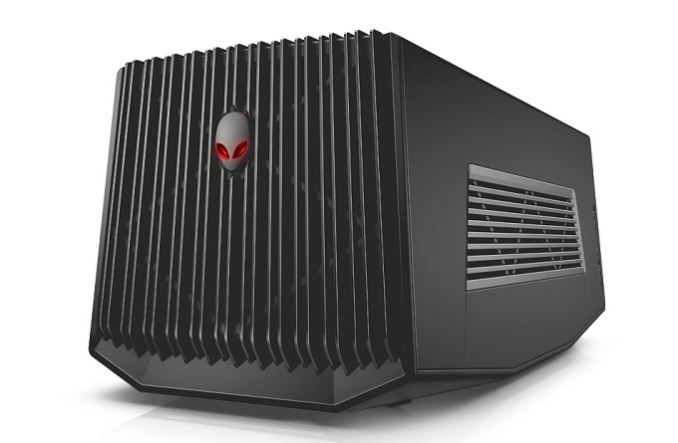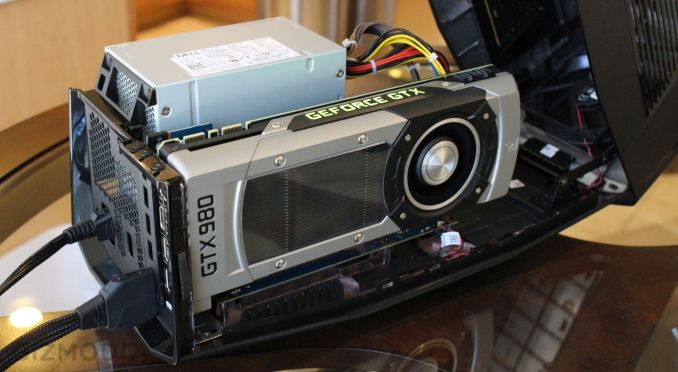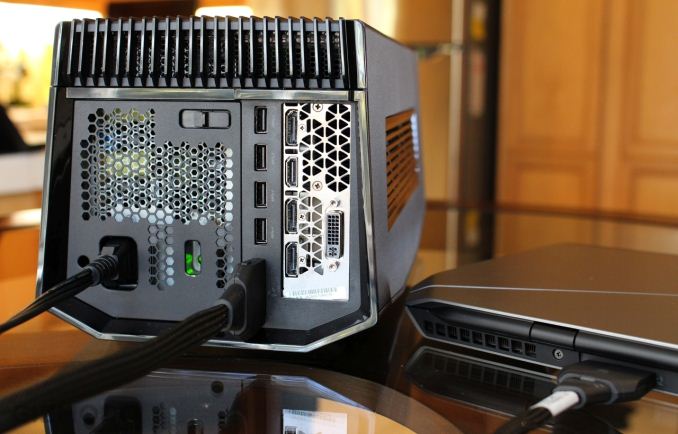Alienware's Graphics Amplifier Announced - An External Video Card Chassis Shipping Soon
by Ryan Smith on October 28, 2014 9:00 AM EST
The idea of an external PCI-Express chassis for video cards is practically as old as PCI-Express itself. However over the years the idea has failed to reach the consumer market as a complete product, even with the introduction of standardized external PCIe interfaces such as Thunderbolt. Various prototypes have been shown, but in practice the only way to acquire such a rig has been to build it yourself, combining an ExpressCard slot and its pokey PCIe 2.0 x1 link with an external PCIe chassis.
Thankfully it looks like the PC industry is finally going to turn the corner on the concept thanks to Alienware. Today Alienware is introducing their own PCIe video card chassis, the Alienware Graphics Amplifier.
Alienware’s amplifier is a fairly typical take on the concept – there are only so many ways to build an external PCIe chassis – however Alienware has been able to put together something that is clearly tuned for video cards. The chassis itself houses a PSU and a single x16 PCIe slot for a video card, along with a quartet of USB 3.0 ports for any other I/O needs. Notably, Alienware has designed the amplifier to be able to handle double-wide video cards up to 375W, which is quite a bit more power than professional grade external PCIe chassis, and this means it can conceivably run just about any self-contained video card on the market. That said, like many small form factor computers the amplifier is also clearly designed for video cards with fully exhausting blowers, so it’s going to be best paired with reference model video cards since blowers are nearly non-existent in custom cards these days.

Alienware's Graphics Amplifier Opened (Image Courtesy Gizmodo)
More interesting perhaps is the PCIe interface, which up until now has always been the sticking point in getting a video card chassis to market. The good news is that Alienware has more or less solved the problem, but the bad news is that the interface is a proprietary Alienware/Dell design that is only available on their laptops. Alienware notes that the interface is actually a PCIe + USB interface – apparently carrying USB over from the host rather than using PCIe to power a separate controller – and in the meantime we’re still working to determine just how many PCIe lanes the interface is carrying. Even if it’s not a full 8 lanes (the Haswell U series CPUs don’t support 16 lanes), given the severe bandwidth limitations of ExpressCard and Thunderbolt, even a 4 lane setup would represent a significant improvement in bandwidth. Like Thunderbolt however this interface does appear to use active cabling (it would be very difficult to carry that much bandwidth externally without it), in which case the cable is going to be an expensive part of the entire setup.
On the host side, the amplifier is being launched alongside the Alienware 13, which will be the first of what will presumably be a series of Alienware laptops to support the amplifier’s interface. Rather than hanging off of spare PCIe lanes, we suspect some kind of MUX is in play here, as Alienware has noted that the 13’s internal dGPU (a GeForce 860M) has to be shut off to use the amplifier interface. Most likely Alienware is rerouting the GPU’s lanes to the interface when it’s in use. Activating or deactivating the interface does require a reboot, which although not especially convenient bypasses some very messy issues that could occur when hot-plugging an active GPU, and we suspect would otherwise be a show-stopper.

Alienware's Graphics Amplifier Up Close (Image Courtesy Gizmodo)
Meanwhile it’s interesting to note that in their development process Alienware has been able to solve some of the technical issues around an external video card in the process to better integrate it with the host. The video card in an amplifier can be used to drive both external and internal displays, meaning that it’s possible to use the amplifier to drive the 13’s built-in display and still reap the benefits, even without an external monitor. The overall non-portability of the 7lb+ amplifier and the USB ports strongly drives the amplifier towards being used as a docking station with an external monitor, but if you want to use it to drive the internal display that is going to be a viable option.
Moving on, Alienware is taking a vendor agnostic approach with the amplifier and will be supporting NVIDIA as well as AMD GPUs. There are still some additional technical details we’re chasing down on how this will work with the internal display capabilities, but ultimately it means the amplifier can be used with a wide range of cards from both vendors. That said, since the amplifier is going to be best paired with a blower type video card, NVIDIA’s cards are going to be the more natural fit at this time. Alienware has been showing the amplifier off with the GTX 980, and next to being the most powerful single-GPU video card on the market it also has a reference blower that is an excellent match for the amplifier’s cooling capabilities.
Finally and perhaps most importantly, Alienware has made it clear that the amplifier isn’t a prototype and won’t be vaporware, and that we’re looking at an external video card chassis that is actually going to ship. Alienware will begin taking orders for the amplifier today alongside the Alienware 13 laptop, with the hardware shipping in November. Even the price is decent (especially compared to DIY attempts), with the amplifier set to cost $299. This is on top of the price of the Alienware 13 laptop and the video card to fill the amplifier with, so the total cost of a setup is still going to be significant, but despite being the first shipping consumer solution it’s not priced through the roof.
Source: Alienware










80 Comments
View All Comments
Sm0kes - Tuesday, October 28, 2014 - link
"...but in practice the only way to acquire such a rig has been to build it yourself, combining an ExpressCard slot and its pokey PCIe 2.0 x1 link with an external PCIe chassis."Ryan, unfortunately you're a few years behind the latest developments in the DIY eGPU space. There are now several cost effective TB / TB2 solutions available (Akitio Thunder 2, Sonnet III-D, Sonnet SEL) that offer significantly improved performance.
I would suggest swinging over the TechInferno eGPU forum and checking out the dozens of example implementations and real world benchmarks: http://forum.techinferno.com/diy-e-gpu-projects/65...
The bottom line is this solution is dead on arrival. The proprietary connector will limit the success and adoption of this. Although, I don't blame Dell here. Intel's unwillingness to certify any Thunderbolt solution aimed at graphics cards is forcing vendors to resort to alternative interfaces.
NA1NSXR - Tuesday, October 28, 2014 - link
They should've used a 1U sized PSU.Manch - Wednesday, October 29, 2014 - link
Looking at the prices for the option, yeah it is. Alienware makes nice machines. Before Dell bought them out, they were the machines I wish I had. After Dell bought them I was concerned but they have continued to produce nice hardware albeit still expensive. I understand you're paying for the name but I had hoped being bought by Dell would enable them to leverage those perks and bring down prices a bit.I really like the concept of an external graphics card so I can replace my DT & laptop with one system. I however am just unwilling to pay the premium they're charging. Until prices come down to earth for a feature such as this, Ill be happy with syncing my data accross my devices.
MDX - Sunday, November 2, 2014 - link
The machine + box is cheaper than the other machines I was considering before the announcement (Aorus X3 and Razer Blade). Not sure how price is the barrier there? I just wish it had macro keys like the Aorus ;)cjb110 - Wednesday, October 29, 2014 - link
People keep mentioning the Intel policy issue re eGPU and thunderbolt, anyone know more about the why? It just seems unlikely Intel would have this without a damn good reason. Is there some certification, health and safety type thing people aren't aware off?rhx123 - Wednesday, October 29, 2014 - link
I made this post on T|I a while back but my theory still stands:They don't want a docked laptop to be as fast as a desktop, so when someone needs mobility and desk-bound performance, they are forced into buying a laptop and desktop both with Intel silicon.
The same shows with Ultrabooks, they are not pushing displayport at all, and when you do get one with displayport, MST isn't supported so you can't really run multiple monitors easily. I think Intel now see most laptops as companion devices, or at least more dumbed down than stuff like the proper EliteBooks.
This is further evidenced by the dropping of 16x 3.0 PCIe lanes from Haswell ULV.
extide - Thursday, October 30, 2014 - link
I think they totally missed the opportuinty to have this essentially be a full docking station. What I mean is that it should:-Provide power TO the laptop
-and include support for ethernet and audio jacks and such
so that you basically only need to hook up the one connection and boom, your laptop has everything connected.
MDX - Sunday, November 2, 2014 - link
I spoke with dell's director for product dev at PAX yesterday, and he said the cable and the connector are not proprietary to dell and that dell has not patented them. He said the only thing proprietary is their software solution that prevents accidental cable disconnection from potentially damaging the hardware.MDX - Sunday, November 2, 2014 - link
Forgot to mention that he also said they're going to include broadwell as soon as intel releases it.vang024 - Monday, November 3, 2014 - link
I'd get it if it will work as a docking station for a Surface Pro 3 or Yoga 2 Pro.